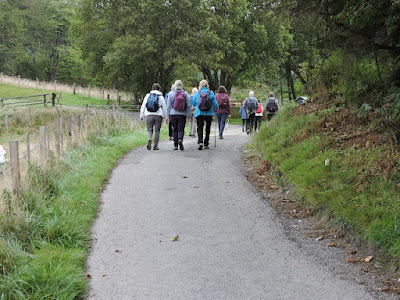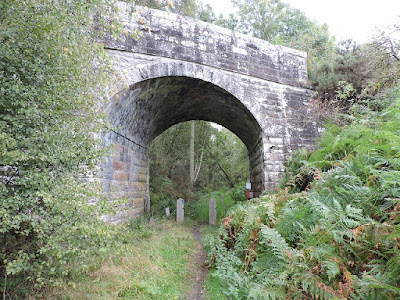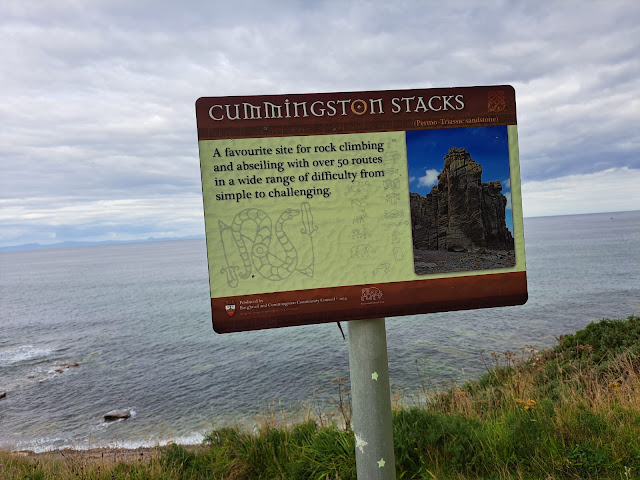Another walk and another non-attendance by us. We were away dog sitting!
This means, of course, that I have to make the blog up as I wasn't there. Not unusual, but the greater difficulty lies in not knowing the order in which the photos were taken. However, I have come up with a pragmattic solution to this. It was a circular walk, so the beginning and end don't matter. Indeed, the end was also the begining. My solution would be better than trying to find the beginning and the end of what might be described as an endless or beginingless thing. A bit like consciousness. The Dalai Lama once noted that consciousness had to be beginingless, because consciousness would require an earlier moment of consciousness and then that earlier moment would require an earlier moment still and so on. It is, in effect, infinite and beginingless.
Accordingly, I will just describe each of the photos in turn and as they arrived in my phone.
A beach. Perhaps this is a fitting beginning as evolution would have us believe that we evolved from creatures that crawled out of the sea - the beginnings of our humanity, so to speak. I don't think that we started out as fully formed swans, though. More like the green stuff round the edges.

This is the Teal, a diving operations vessel, which was berthed at Burghead, having sailed from Invergordon about 2 weeks before the Dinos came toe Burghead. This might suggest that this was the start of the walk, but it might be the end, because Burghead was the start and the finish. Similarly, the Teal might or might not be a military vessel. who knows?
Step we gaily, on we go,
heel for heel and toe for toe!
Red their cheeks as Rowans are,
after stepping up the stair.
( I changed the words a little bit there), and what was Pam doing?
Over hillways, up and down,
Myrtle green and bracken brown,
Past the sheiling, through the town,
All for sake of Mairi.
I can only assume that this is Mairi on the right of the photo.
Pam has shed some clothes now and is stepping out, but not so gaily it would seem.
The view was worth it though, although, rather alarmingly, the sea is draining away to the left of the photo. Probably global warming!
More stepping gaily, past the sheiling, through the town.
Burghead is famous as the site of a very large Pictish Fort and, indeed, one of the largest forts of any kind in Scotland. However, I'm prepared to bet that this wee carved cross is not Pictish in origin, although it is worth noting that there were up to 30 Pictish carvings found here, of which only a few survive.
This, on the other hand isn't even pretending to be Pictish.
Oh Well. What can I say about this?
This commonly known as St Aethan's well. St Aethan, may or may not have existed and may or may not have been martyred and thus, a saint. St Aethan is sometimes mixed up with St Adrian or with St Ethernan. All of them were originally assumed to be monks living in the Isle of May and being followers of St Columba. They were also thought to have died among the Picts, who they were trying to convert to Christianity. Then a scholar suggested that the old writings should have translated that they were killed by the Picts.
The well was apparently very important to Burghead people. So much so, that it was used as a meeting place almost within living memory. Water from the well was bottled and taken to relatives living elsewhere, so that they might benefit from its healing properties. These properties are, apparently, non-existent as the water contains nothing of any curative worth. The well has been restored in the last 10 years as it was filled in by a farmer after one of his cows fell in and was injured.
It might be a bit early, but Jimmy and Liz managed to find some brambles to stave off their apparent hunger.
Everybody waited for Maureen to bring out the tablet!
Well, well. The Cabrach Well, which is fed by run off from agricultural lands uphill. I wouldn't recommend a cooling drink from here.
Dave looks like he is going to give us every verse of the Star Spangled Banner, which is famously difficult to sing. Weirdly, the tune was not written for the song. The tune was originally for the Anacreontic Song, which was composed for the Anacreontic Club - an 18th Century gentlemen's club in London. It was dedicated to Anacreon, who was an Ancient Greek poet renowned for drinking songs and odes to love.
The Bootlegger's Bistro, came after Dory the Double Decker in real life, but comes before Dory in this beginingless tale. It is supposed to be very good, so I should go sometime.
Liz contemplates a dip.
Instead, they all sit down for lunch.
Liz seems very disappointed in her choice of sandwich, whilst Jim and Jacque are delighted with theirs.
Jimmy and Hugh are craning their necks to see Dave.
A flag pole, made from the mast of an old fishing boat marks where one of the Royal Family, who nobody mentions any more, commemorated the founding of Hopeman 218 years ago. Well, he raised the flag in 2005 for the 200th Anniversary and that was 18 years ago.
Ooops, back to lunch.
Dory the Double Decker was a pop up restaurant that was forced to close during the pandemic. That led to the creation of the Bootlegger's Bistro and Grill, which they passed by earlier.
The only way is forward.
We don't see many under the bridge photos.
Walking towards the Burghead Maltings. These are one of the largest drum maltings in Europe. They produce 25% of the annual Scotch Malt Whisky requirements every year. They are actually linked to the Roseisle maltings with heat and production water pipes running between the two plants.
Lots of water and 2 boats. I was aware that they saw dolphins leaping, so I have assumed this photo is related to that, although I cannot see any dolphins there, but there might be a seal in the bottom right.
Now an over the bridge photo, but a different bridge, I think
The Cummingston Stacks are, as the sign says, great for rock climbing. The stacks are colour banded and show variable rates of erosion. This is due to the differing iron content of each bed of rock. Just round the corner from the stacks the shore shows clear signs of ancient sand dunes. These indicate that this was once part of a hot, arid desert a lot closer to the equator than it is now. Of course, that was about 300 million years ago, so no need to go looking for camels and oases, yet.
There are still sand dunes, though.
Now, is Hugh batting away flies or, is he clutching his head in exasperation at something that Pam has said to him?
This, I think is Coral Weed. It is widely distributed around the UK coastline and is common throughout most of the North Atlantic, but is also found in Japan and Australia. It was once harvested for use as a vermifuge. I had to look that up - it means it was used as a means of expelling worms from your intestine!
Masonhaugh Quarry is world famous for finds of Permian mammal footprints - that is they are 300 million years old. Some of the prints are unique in the world, whereas others have been found in other UK and European locations. It is considered the one of the best Permian footprint locations in the country.
I assume that this is the group back in Burghead watching Pam show off her dance moves.
Burghead Harbour is relatively new, dating from 1810 or so. It has been altered and extended since then. As is often the case with harbours at this time, Thomas Telford had a hand in the design. It was used for up to 400 boats at one time and trade went as far as London and Europe. There were regular steamer visits in its heyday.
It almost looks like Hugh and Dave are jogging along the promenade, but I feel that is not really likely.
Here is the happy band at the end (or, perhaps the beginning) of the walk. I think Sandra is actually asking if this is the beginning or the metaphysical end.
Hugh had earlier tried to sneak away so as to avoid any further discussion of beginingness
Luckily, it was the end, but also the beginning of a little sit down for tea and cakes.
t

It looks like they all had a good time. Well done to Dave and Sandra for their organisation and to Jacque for the photos.







































.jpg)






































